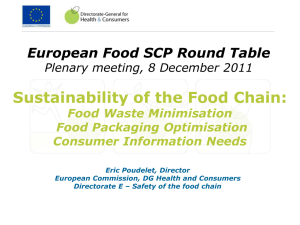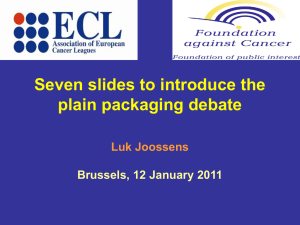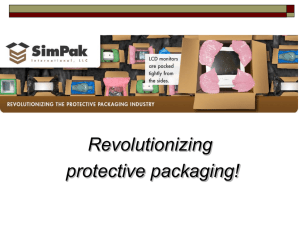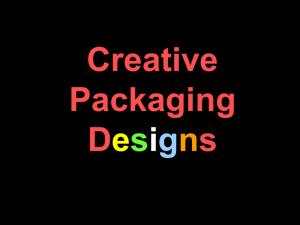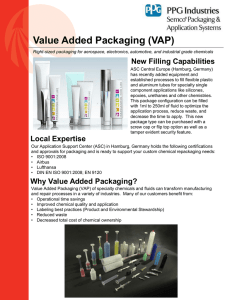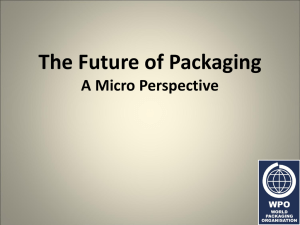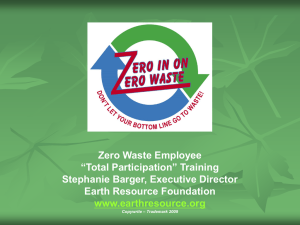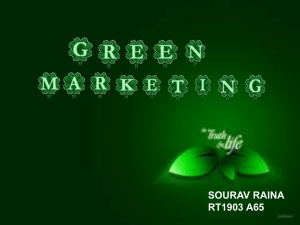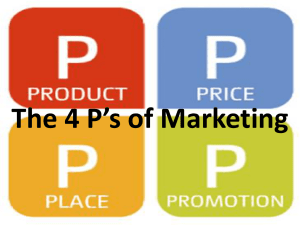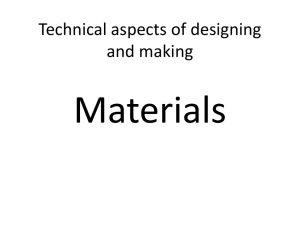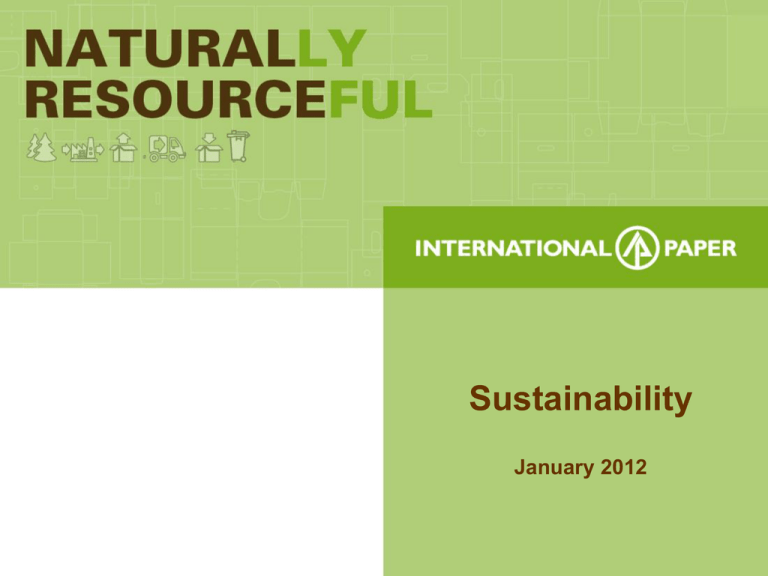
Sustainability
January 2012
Sustainability- What is it?
Sustainability is meeting present needs without compromising the
ability of future generations to meet their own needs*
Vibrant
Economy
Social
Equity
Sustainability
Healthy
Environment
To International Paper this means . . .
1.
Managing Natural Resources
2.
Reducing Environmental Footprint
3.
Building Strategic Partnerships
* Source: Brundtland Commission
Guiding Principles
Evaluate the entire supply chain for sustainability opportunities
•
•
•
•
•
•
Raw Material
Manufacturing
Packaging Design
Distribution
Product Use
Recovery / End of Life
Build partnerships for
greater success
• Collaboration helps
uncover additional
opportunities
• Partnering enables supply
chain improvements
beyond one’s own
company
Raw Material Sourcing
Managing Natural Resources
Renewable
Paper-based packaging is made from trees, a renewable resource-- our fiber-based packaging is 100% renewable
Third-Party Certified
Our containerboard and boxes are third party certified
Our use of a particular standard is dependent upon the location of the facility or forest--sourcing fiber from the
closest source is one way that we ensure our environmental responsibility
Currently 100% of our boxes can be labeled with the SFI Fiber Sourcing logo
Regenerate the Forest
Regeneration is a critical component of the forest life cycle, and use of our corrugated packaging encourages long
term, responsible forest stewardship
Demand for trees helps ensure that tree farmers will continue to keep their land forested rather than sell their land
for development or clear it to grow other crops
Demand for wood-based products helps to maintain forests and ensures that trees are managed responsibly
Recycle Balance
We balance renewable, virgin fiber with recycled fiber for optimal performance for our customer’s supply chain
Third-Party Certification
Certification ensures wood fiber is tracked from the forest to the
consumer, with assurance that it comes from responsibly managed forests
Organizations like the Sustainable Forestry Initiative (SFI) set
certification standards, then accredited auditing firms verify a company’s
performance against those standards–much like a financial audit verifies
a company’s financial performance
Certification is supported by conservation groups, fights illegal logging
while recognizing rights of indigenous peoples and protects water, soil,
wildlife, and endangered forests
90% of paperboard and 93% of containerboard produced in
the United States is supplied by SFI Participants
The SFI® mark is a registered mark of the Sustainable Forestry Initiative
.
Certification Statistics
How Many Forests Are Certified?
Across the world less than 10 percent of forests are certified,
and in North America, approximately 30 percent are certified.
U.S. Forestland Ownership
Who owns the American Forests?
Government-Owned
(146 million acres)
Privately-Owned
(356 million
acres)
Because approximately 70% of U.S. forestland is privately-owned,
certifying forests is difficult and very fragmented
Commitment to 3rd Party Certification
International Paper supports 3rd party certification – all credible
organizations
Our use of a particular standard will be dependent upon the location of the
facility or forest
The idea that one forest certification system is preferable over all others is
based on non-empirical, obsolete information
We believe that the focus should be on reaching the 90% of the forests that
are uncertified with improved standards, rather than debating areas that are
already sustainably managed
Our global certification policy and the certification status of our operations
are publicly available at ipsustainability.com
Balance in Sources of Fiber
Which is better virgin (new) or recycled?
Recovered Fiber
Virgin Fiber
Collection/separation
Harvest
• Distance to transport
• Distance to transport
• Re-pulp & de-ink
• Chip & pulp
• Fossil fuel energy
• Biomass energy
• Solid waste
There is no one “right” answer -- each choice results in tradeoffs
between performance and environmental impact
Virgin vs. Recycled Comparison
Over the lifetime of a box
Performance was
similar in the first
2,000 minutes, after
which the recycled
box failed
And eventually (after
5,000 mins) so did
the virgin box
Considerations for your supply chain requirements and demands
should be assessed to get the optimal performance.
Cyclic humidity (50% RH for 6 hours 90% RH for 6 hours .Loaded at 6.4% of BCT(or 11.4% of BCT @ 85%RH
Summary Virgin vs. Recycled
Which is better for the environment?
It Depends!
Paper fibers can be recycled an average of 4-7 times, so both are
essential to making the entire system more sustainable
There cannot be recycled paper without virgin paper to begin and sustain
the cycle
Virgin fiber that is grown and harvested sustainably helps keep private
land forested
Requiring SKU / product specific recycled content percentages suboptimize the system and can lead to less sustainable practices
IP finds the best suitable outlet for the fiber, leading to a
balance between virgin and recovered fiber.
Manufacturing
Reducing Our Environmental Footprint
Energy
Our mills use >70% renewable energy which is self-generated and carbon neutral
Since 2003, IP has invested over $250 million in energy efficiency improvements.
Green House Gas (GHS) Emissions
We are founding members of the voluntary Chicago Climate Exchange (CCX) and the EPA Climate Leaders
Program in the U.S.
Under the Climate Leaders program, we committed to reducing emissions 15% from 2000-2010, and exceeded
that goal by double
Fuel
We have increased the amount of renewable fuel usage by over 5%since 2004, and decreased fuel oil and
natural gas use by 49% per ton of product since 2001 in the U.S.
Water
We are focused on water conservation, recycling water within our mills and protecting water quality in waterways
that receive our water after use
From 2004-2008, our effluent decreased by 4%
When accounting for evaporation and precipitation, over 99.5% of total water inputs are returned to the
environment
GHG Emissions
Under the Climate Leaders program, we committed to reducing
emissions 15% from 2000-2010, and exceeded that goal by double
Climate Leaders Data, includes all US Operations
Packaging Design
Remove
Through innovative paper and packaging design, we have made extensive progress in removing unnecessary
packaging and less desirable materials while delivering value to suppliers, retailers and end-users
Reduce
Using performance-based and lighter weight papers and liners, our design experts optimize the amount of
material in the packaging, so it’s not over engineered but serves its purpose across the supply chain
“Right-size” and optimize packaging design for performance, product-to-packaging ratio and cube utilization for
efficiency across the supply chain
Renewable
Our structural design experts help customers determine the right balance of fibers and the right packaging
design to minimize material requirements without compromising strength and performance
Recycle / Recyclable
Our corrugated packaging is 100 % recyclable and contains an average of 34% recycled content
We offer many innovative solutions that replace packaging materials that are not recyclable
We collectively improve packaging sustainability and the environmental impact when we share the
latest innovations, collaborate together and incorporate new ideas into products and activities
Remove Packaging
CORRDrum™ with Triplewall Corrugated Technology™
A revolutionary all corrugated drum which replaces fiber, steel, plastic, and composite drums
• Made from recyclable linerboard and medium
• Complies with SFI sourcing standards
• Can be reused after providing product protection and
end-user or consumer storage
• Used in a variety of food products such as cereal,
pasta, vegetables, and industrial chemical products
• The package is recyclable with OCC eliminating the
cost of landfill disposal and can provide revenue to
retailers and end-users
Reduce Packaging
Box Compression Test Pro
Box Compression Test Pro (BCTPro), International Paper’s corrugated
packaging solution helps suppliers of Wal-Mart improve their sustainability
commitments.
• Proprietary technology built in to BCTPro helps deliver
packaging solutions that perform throughout the supply chain
• BCTPro tests result in better
utilization of materials, transportation
and energy
• Optimizes corrugated packaging
solutions by removing unnecessary
packaging and reducing suppliers’
total costs through the supply chain
Reduce Packaging
Square or near square RSCs waste material
Resizing for same cube or reorienting the opening can reduce
blank size
20 x 20 x 10
17.4 Sq ft
20 x 10 x 20
13.2 Sq ft
24% reduction
Reusable Packaging
• Display-Ready Packaging for Fresh Produce
• Using performance-based papers, optimized basis weights and
removing excess materials “right-sizes” the packaging
• Improve efficiency and retail appeal while
reducing material use, “less desirable
materials,” handling and waste
• Common footprint, modularity, and shelfready packaging minimize waste and
improve cube utilization
Distribution
Global footprint
Our vast geographic footprint enables quick delivery and speed to market, which equals quicker
sales and realized profits
Strategic locations close to major retailers to better serve them and our CPG customers
Transportation
Multiple locations reduces travel distance
Turnkey solutions under one roof enable manufacturing, pack out, etc. to all occur in one location vs.
travel from facility to facility
Through optimized design, we reduce materials used, maximize cube utilization and product-topackaging ratio, freight costs and reduce truckloads and lower green house gas emissions with less
fuel
Warehouse
Efficiency gains in labor and warehousing with fewer pallets, modular designs, and shelf-ready
packaging
Reduce Packaging
Power Wing Display / Self-Shipper
Reduces the environmental footprint of the standard
power wing display by minimizing the number of components and
eliminating the master shipper
•
Self-shipping display uses an “overwrap” with a
perforated die-cut that can be removed for
easier retail setup
•
40% less corrugated material used – reduction
of display components and no master shipper
•
Overall cost savings – 4 fewer pallets needed for
same quantity of displays shipped
•
The gravity feed design provides large billboard
space to communicate brand message and
product benefits
Product Use
Reuse
Our corrugated containers are often used multiple times to transport, protect and store products. Our
engineers develop packaging systems with the entire supply chain in mind and use materials that are
reusable and returnable
Our corrugated packaging is 100 percent recyclable, so after its initial useful life it can be recycled
and reused to make another product
Performance
Products are designed and engineered for top performance with minimal environmental impact—from
protection and retail sales to reusability and recoverability
Design incorporates in-store activities to minimize the number of components and complexity of
getting the display to the retail floor and shopped by the customer
Reusable Packaging
Bulk Bin Packaging
International Paper engineers develop multiple-trip and closed-loop bulk
packaging systems for the supply chain with corrugated materials that are
reusable and returnable.
• Many paper-based packaging solutions produced by the company
can be reused after providing product protection and end-user or
consumer storage
• Freight, labor, warehousing, and waste
are reduced with International Paper
reusable bulk packaging systems
• Used in a variety of food products such
as pumpkins and watermelons
Recovery / End of Life
International Paper Recycling
One of the largest recyclers in the world, with extensive experience in recycling services
A leader in buying and selling recovered paper to mills globally, recovering more than six million tons of
recyclable products each year
Well positioned geographically with 20 facilities in the U.S. and Mexico to serve customers in North America and
close to major ports for export access
Recycling Services
Results
Our consulting expertise identifies areas to reduce costs or improve profits,
We help maximize warehouse space for product inventory, maximize the life of recovered fiber by using it in the
most optimal application, reduce landfill waste and improve customers recycling revenue stream
Recycle(able) Packaging
Use materials made of the highest recycled content without
compromising quality
• In 2008, recovery of Old Corrugated
Containers was 81%
• But paper production can not rely on
recovered fiber alone - Paper fibers
can only be recycled 4-7 times
• Recovered fiber growth rate is slower than
the projected global fiber demand needs
• International Paper is one of the world’s
largest paper recyclers – 6 million tons
collected
• International Paper’s corrugated packaging
contains an average of 34% total recycled
content
Recycle(able) Packaging
TM
ClimaSeries - the latest technology in
cold chain packaging that replaces
waxed boxes
• Recyclable - Unlike wax products, ClimaSeries® boxes
are salable though the regular OCC recovery system.
• Performance - Boxes that meet or exceed the performance
of the entire spectrum of current waxed packaging.
• Cost-Effective - ClimaSeries® products help you get
product to market fresh, protected, and in a
recyclable package. ClimaSeries® products are
cost-effective from a product and supply chain
perspective.
Recycle(able) Packaging
“Duracool”
Display-ready, fully recyclable alternative to Expandable PolyStyrene (EPS)
packaging
• Recycles with other OCC and also reduces packaging, freight, and retailer
labor costs throughout the supply chain.
• Certified under the Fibre Box Association
protocol as fully recyclable and fully
repulpable
• Specially treated package assures
ambient moisture and fungicide
treatment stay on grapes instead of
being absorbed by the package
Partnerships for Greater Success
Partnering with International Paper’s packaging team
gives you experts at every stage in the lifecycle of your
corrugated packaging
We can help optimize fiber use and reduce
environmental impact throughout the supply chain
We build sustainability into your business with products
and practices that are not only the right environmental
choice, but also the smart economic choice
Wal-Mart’s Sustainability
Improvement Goals
• Be supplied 100% by renewable energy
•
Existing stores 20% more efficient in 7 years
•
New stores 30% more efficient in 4 years
•
Trucks 25% more efficient in 3 years; 50% in 10 years
• Create zero waste
•
25% reduction in solid waste in 3 years
•
All private brand packaging improved in 2 years
• Sell products that sustain resources and
environment
•
20% supply base aligned in 3 years
•
Preference given to aligned suppliers in 2 years
Wal-Mart’s Packaging Scoreboard
Metrics Used to Evaluate Packaging
METRIC
DESCRIPTION
WEIGHT
Greenhouse Gas
Emissions
Auto-populated by material with
industry average CO2/ton
15%
Sustainable Material
(Material H&S)
Material Health & Safety based on
industry average OSHA score
15%
Product-Package Ratio
Amount of packaging relative to product
driven by # units, weight (SKU spec.)
15%
Cube Utilization
Measure of fit – product to package ratio
(SKU specific)
15%
Transport Distance
Distance converted packaging travels to
‘pack-in’ facility
10%
Recycled Content
Auto-populated by material with
industry average recycled content
10%
Recovery Value
Auto-populated by material with
industry average recovery rate
10%
Renewable Energy
3rd party evaluated usage
5%
Extra Credit / Innovation 3rd party evaluated energy efficiency, etc.
5%
Summary
Paper based packaging is inherently sustainable
International Paper has a strong sustainability platform
Renewable and recycled fiber sources
Biomass utilization and greenhouse gas reductions
Performance and design optimization
Wal-Mart’s scorecard reflects an understanding of the integrated nature of
the global corrugated packaging industry Scorecard using industry
averages for many attributes for corrugated, not an individual company’s
recycled vs. virgin.
Packaging design (product to packaging ratio and cube utilization) is
critical as you can directly impact the score at the SKU level
International Paper has the tools, resources, and track record to help you
with your sustainability goals and improve your scorecard results
NOTICE: The information contained in this document is confidential
and proprietary to International Paper Company ("IPCO") and no
part may be reproduced, copied or transmitted in any form or for
any purpose without the express prior written consent of IPCO.
This document and all content are the property of IPCO and is
protected by U.S. and international copyright laws and all rights are
reserved worldwide. Use of the copyrighted content is subject to
the terms and conditions of use established by IPCO. Nothing
contained in this document should be construed as granting any
license or right to use any of the copyrighted content without the
prior written permission of IPCO. The logos, trademarks and
service marks that appear on this document are the exclusive
property of IPCO or of other respective owners and no use or other
rights are granted without the express, written approval of the
owner.

